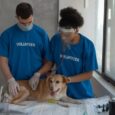Owners commonly inquire about their pet’s healing time after surgery. The fact is that there is no such thing as a one-size-fits-all schedule. The time it takes for a dog or cat to recover is determined by different factors, including the animal’s age, health, fitness level, and the surgery undertaken.
Dog’s Recovery Process After a Surgery
Surgery can cause worry and anxiety in both people and pets. The healing process is simple; however, your pet will usually need special care in the weeks following surgery. Follow these simple tips if you like to help your dog recover fast, easily, and successfully.
Keep Them Warm
You like to help your dog keep the ideal temperature, particularly since anesthesia can affect your pet’s ability to manage his body temperature. Your pet won’t know if it’s hot or cold for the first few days, so monitor his temperature and always keep them warm.
Isolate Them
Keep a safe distance between your pet, other animals, and kids. Even the kindest family puppy may be a bit more irritable than usual throughout recovery. Because they are stressed and vulnerable, they might snap or bite. Furthermore, other pets and children may be too loud for a sensitive dog recovering from surgery.
Discomfort, stress, and disorientation are common post-surgery signs that will subside, so do not be alarmed if your pet seems to be acting oddly. Isolating dogs for 2 weeks after surgery is suggested by vets. In case of emergency, visit Affordable emergency vet in Tracy.
Keep Them Hydrated
Even if your dog does not appear thirsty after surgery, it is essential to keep them hydrated. After surgery, keep an eye on your dog’s drinking to make sure they get enough water. Give little food; veterinarians suggest something bland like chicken or hamburger meat; however, no treats unless there are food intolerances.
Give Routine Wound Care
To help them recover fast and reduce the risk of infection, either you or your vet must clean and replace bandages on your dog’s wounds frequently. Ideally, your vet will teach you how to properly take care of their wounds, instructing that you change gauzes 2 or 3 times a day at first. You’ll be able to look at the bandages every several days eventually, but make sure to follow your vet’s guidance. Visit affordablepetvetclinic.com for more information about post-operative care for your pet.
Routine Checkup
Checkups for pets follow a set of processes. There are a few basic procedures that can be included. Examinations include:
- Health Assessment – A routine health examination will be performed by the veterinarian to search for any obvious signs of disease. At this moment, you should raise any questions or worries you have about your pet’s health.
- Vaccinations – Vaccines that have not been given in a year will be given again. Certain vaccinations, like rabies, are now provided every 2 years or less often. The period between rabies vaccinations differs depending on the veterinarian. Learn more about pet vaccinations in Tracy, CA.
- Parasites – Your pet will be inspected for flea, tick, or worm problems. To check for worms in cats, they should undergo an uncomfortable stool sample test. Be informed that your cat will be upset, but the procedure is quick and needed for your cat’s health.
- Nutrition and Behavior – Your vet will examine whether your animal is underweight, overweight, or normal weight. The vet might then recommend dietary or exercise adjustments as required.
Conclusion
The most responsible pet owners will take significant steps to protect their precious pets’ security. These owners will invest thousands of dollars to save their pet’s life if hurt or ill. Surgery can be frightening for both pets and their owners. The recovery process is usually simple, but your pet will need special care in the days and weeks after surgery. Follow the steps discussed above to help your dog recover fast after surgery.





